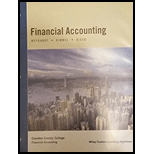
Concept explainers
(a)
Accounts receivable refers to the amounts to be received within a short period from customers upon the sale of goods and services on account. In other words, accounts receivable are amounts customers owe to the business. Accounts receivable is an asset of a business.
Bad debt expense:
Bad debt expense is an expense account. The amounts of loss incurred from extending credit to the customers are recorded as bad debt expense. In other words, the estimated uncollectible accounts receivable are known as bad debt expense.
Aging of receivables:
A method of determining the estimated uncollectible receivables based on the age of individual accounts receivable is known as aging of receivables method.
Allowance method:
It is a method for accounting bad debt expense, where amount of uncollectible accounts receivables are estimated and recorded at the end of particular period. Under this method,
Percentage-of-sales basis:
Credit sales are recorded by debiting (increasing) accounts receivable account. The bad debts is a loss incurred out of credit sales, hence uncollectible accounts can be estimated as a percentage of credit sales or total sales.
It is a method of estimating the bad debts (expected loss on extending credit), by multiplying the expected percentage of uncollectible with the total amount of net credit sale (or total sales) for a specific period. Under percentage of sales method, estimated bad debts would be treated as a bad debt expense of the particular period.
Direct write-off method:
This method does not make allowance or estimation for uncollectible accounts, instead this method directly write-off the actual uncollectible accounts by debiting bad debt expense, and by crediting accounts receivable. Under this method, accounts would be written off only when the receivables from a customer remain uncollectible.
(a)
To identify: Whether Company D uses direct write-off method, or the allowance method for accounting bad debts.
(b)(1)
To prepare: The
(2)
To prepare: The adjusting entry for recording the bad debt expenses at December 31, 2019, under percentage of sales basis.
(c)(1)
To prepare: The adjusting entry for recording the bad debt expenses at December 31, 2019, if the allowance for doubtful accounts have unadjusted debit balance of $1,000.
(2)
To prepare: The adjusting entry for recording the bad debt expenses at December 31, 2019, under percentage of sales basis.
(d)
To prepare: The
(e)
To prepare: The journal entry to write-off $3,000 of accounts receivable as uncollectible, under direct write-off method.
(f)
To identify: The type of account for allowance for doubtful accounts, and show how it affects accounts receivable reported on the
Want to see the full answer?
Check out a sample textbook solution
Chapter 8 Solutions
FINANCIAL ACCOUNTING W/WILEY+ >IP<
- The total assets are?arrow_forwardProvide answerarrow_forwardHow does reciprocal accounting differ from standard intercompany accounting? a. Mutual transactions simultaneously affect both entities' records b. One entity records the transaction first c. Transactions are recorded at year-end only d. Each entity keeps independent recordsarrow_forward
- Kahlo Industries uses a predetermined factory overhead rate based on direct labor-hours. For October, Kahlo's budgeted overhead was $180,000 based on a budgeted volume of 15,000 direct labor-hours. Actual overhead amounted to $192,000, with actual direct labor-hours totaling 14,200. Required: What was over- or underapplied manufacturing overhead in October?arrow_forwardWhat is the total equity for Orion tools at year end ?arrow_forwardPlease provide the correct answer to this financial accounting problem using accurate calculations.arrow_forward
- The financial statements of Isabella Corporation report net sales of $840,000 and accounts receivable of $175,000 and $135,000 at the beginning and end of the year, respectively. What is the average collection period for accounts receivable in days?arrow_forwardCan you solve this general accounting question with the appropriate accounting analysis techniques?arrow_forwardCan you help me solve this general accounting question using valid accounting techniques?arrow_forward

 AccountingAccountingISBN:9781337272094Author:WARREN, Carl S., Reeve, James M., Duchac, Jonathan E.Publisher:Cengage Learning,
AccountingAccountingISBN:9781337272094Author:WARREN, Carl S., Reeve, James M., Duchac, Jonathan E.Publisher:Cengage Learning, Accounting Information SystemsAccountingISBN:9781337619202Author:Hall, James A.Publisher:Cengage Learning,
Accounting Information SystemsAccountingISBN:9781337619202Author:Hall, James A.Publisher:Cengage Learning, Horngren's Cost Accounting: A Managerial Emphasis...AccountingISBN:9780134475585Author:Srikant M. Datar, Madhav V. RajanPublisher:PEARSON
Horngren's Cost Accounting: A Managerial Emphasis...AccountingISBN:9780134475585Author:Srikant M. Datar, Madhav V. RajanPublisher:PEARSON Intermediate AccountingAccountingISBN:9781259722660Author:J. David Spiceland, Mark W. Nelson, Wayne M ThomasPublisher:McGraw-Hill Education
Intermediate AccountingAccountingISBN:9781259722660Author:J. David Spiceland, Mark W. Nelson, Wayne M ThomasPublisher:McGraw-Hill Education Financial and Managerial AccountingAccountingISBN:9781259726705Author:John J Wild, Ken W. Shaw, Barbara Chiappetta Fundamental Accounting PrinciplesPublisher:McGraw-Hill Education
Financial and Managerial AccountingAccountingISBN:9781259726705Author:John J Wild, Ken W. Shaw, Barbara Chiappetta Fundamental Accounting PrinciplesPublisher:McGraw-Hill Education





